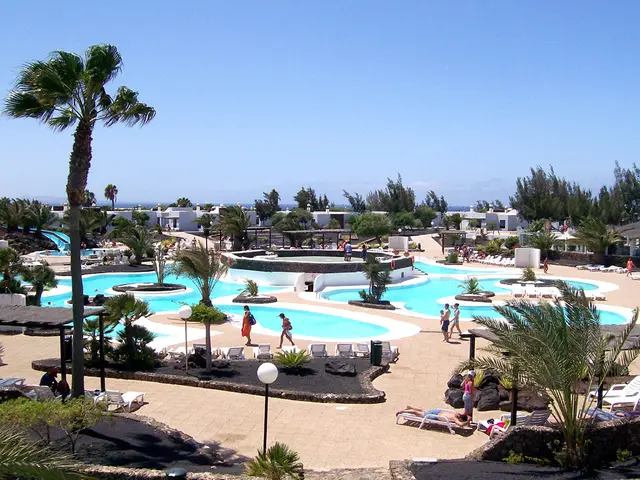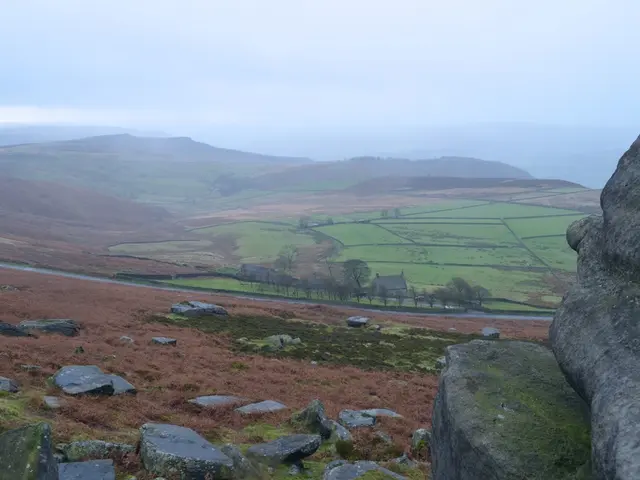Overcrowded holidays: Visitors finding less and less solace in popular travel destinations
In Europe, popular tourist hotspots are experiencing a surge in visitors, with regions such as Scandinavia, Italy, Austria, Spain, Greece, and Switzerland feeling the impact. This trend, often referred to as "Coolcation," is driving an increase in visitors to destinations like Copenhagen and the fjords along Norway's west coast. However, this influx of tourists is not without its challenges.
One such example is the picturesque Austrian community of Hallstatt, home to just 750 inhabitants. The town, famed for its appearance in TV series, attracts over a million visitors annually, many from Asia. To manage this influx, the town's mayor, Alexander Scheutz, has suggested limiting access to the national road.
Similarly, in the Dolomites, four landowners have demanded a five euro toll for access to Seceda, a popular viewpoint, to combat issues like litter, stressed livestock, and trampled alpine pastures.
Spain is another country facing the brunt of mass tourism. The country is on track to set a new tourist record by 2025, with the number of foreign visitors potentially exceeding 100 million for the first time this year. However, this growth has led to resentment towards mass tourism, with consequences such as housing shortages, environmental pollution, traffic chaos, noise pollution, rising prices, and destruction of nature.
Barcelona, in particular, is planning to completely phase out tourist apartment rentals by the end of 2028, aiming to alleviate some of these pressures.
In Greece, super-destination islands like Santorini and Mykonos struggle with cruise tourists arriving in the thousands daily during peak season, now charged a 20 euro entry fee. Authorities are also enforcing the law that at least half of beaches must always be accessible to everyone, due to beach bars and sun loungers taking up space.
Venice, too, is grappling with the effects of mass tourism. Despite generating over five million euros from entrance fees for day-trippers in 2025, the city still faces issues such as overcrowded alleys and irritated residents.
The influx of tourists in Scandinavia is unlikely to decrease due to the climate crisis and the growing trend towards vacationing in cooler climates. In small Scandinavian towns visited by cruise ships, the number of daily visitors often exceeds the local population.
Even in idyllic towns like Iseltwald, near Lake Brienz in Switzerland, the influx of tourists, particularly from Asia, attracted by a South Korean Netflix series, has led to the implementation of a five franc entry fee for visitors.
Italy is also struggling with the balance between hospitality and strain, particularly in popular tourist destinations like Venice and Lake Garda. According to Tourism Minister Daniela Santanchè, 75 percent of tourists concentrate on only four percent of the area, exacerbating the strain on these areas.
While mass tourism brings economic and cultural benefits, it also poses critical environmental and social sustainability challenges. Case studies like Crete illustrate how resource overuse and social tensions threaten long-term viability without integrated management linking tourism planning and resource governance.
Countries like Spain, Greece, Iceland, and Belgium are adopting smarter management strategies to mitigate overcrowding and its consequences on local communities and environments, balancing tourism growth with sustainability.
However, creative solutions are also emerging. In Mallorca, activists have placed fake signs warning of jellyfish, rockfalls, or swimming bans to deter tourists from beaches. In Mykonos, the high cost of living has made it so expensive that few Greeks can afford to holiday there.
As Europe continues to attract tourists, it is crucial for local communities and governments to find ways to manage this growth sustainably, ensuring that these treasured destinations can be enjoyed for generations to come.
[1] European Commission. (2020). Tourism and Sustainable Growth: A European Agenda for Jobs, Growth, and Investment. [2] European Parliament. (2017). Report on the Impact of Tourism on the Environment and Climate Change. [3] United Nations World Tourism Organization. (2018). Tourism for Sustainable Development: Policy Guidelines. [4] World Travel & Tourism Council. (2019). Tourism's Role in the Sustainable Development Goals.
- Europe's popular tourist hotspots, such as Hallstatt in Austria and Seceda in the Dolomites, are implementing measures like access limits and tolls to manage the influx of visitors, due to concerns about environmental degradation, litter, and stressed livestock resulting from mass tourism.
- To mitigate the effects of mass tourism and ensure the long-term viability of its destinations, countries like Spain, Greece, Italy, and Switzerland are adopting smarter management strategies, drawing from resources like the European Commission's Tourism and Sustainable Growth agenda, the European Parliament's report on the impact of tourism on the environment and climate change, and the United Nations World Tourism Organization's guidelines for tourism for sustainable development.




